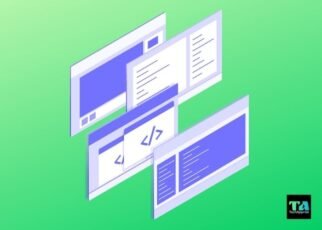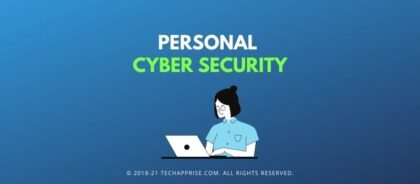If you’re looking for the easiest programming languages to learn, then this post is RIGHT for you.
With the enormous rise in demand for programmers and developers all around the globe, you might have decided to build your career in cybersecurity or software engineering. Or maybe just wondering, what are the easiest programming languages to learn for beginners?
There are around 7,117 languages are there in the world and 700 programming languages including the Esolang (used to test the boundaries of languages).
Though it’s obvious that all of these languages are not in use anymore, still the number is huge. If you are new to this field, you may get easily intimidated or overwhelmed due to the vast variety of languages available to learn.
To make it easy, I’ve created a curated list of the best programming languages to learn. Keeping in mind, the ease of learning, as well as the demand in the job market.
| Programming Languages | Level | Applicability |
|---|---|---|
| 1. HTML | Very Easy | Web Development |
| 2. Javascript | Easy | Web Development (Frontend), Mobile Apps, Game Development |
| 3. Python | Easy | Artificial Intelligence, Machine Learning, Data mining |
| 4. Ruby | Easy | DevOps Tools, Servers, AI, Machine Learning |
| 5. Java | Moderate | Mobile Apps, Internet-of-Things (IoT) Devices |
| 6. Php | Moderate | Web Development (Backend) |
| 7. R | Easy | Data Analysis, Data Scientists |
| 8. Rust | Moderate | Automation Systems |
| 9. Go (Golang) | Easy | Big Data, Servers, Network Programming |
| 10. Swift | Moderate | Applications for Apple (iOS) devices |
The best part?
All these easy programming languages have worked really GREAT throughout the last several years and will continue to boom in this decade.
Factors to Decide Easiest Programming Languages
In order to filter out and decide the easiest programming language among a pool of over 700 languages, I’ve considered these 5 crucial factors that are listed below.
- Ease of Learning
- Popularity of Language
- Job Market of Language
- Demand in the Future
- Applicability in Real Life Projects
What are the Easiest Programming Languages to Learn?
Now without further ado, let’s take a look at all these easy programming languages.
1. Python

Python is the world’s fastest-growing and most popular programming language.
It’s not just popular among software engineers but also mathematicians, data analysts, scientists, accountants, network engineers, and even kids.
The reason? Because it’s a very beginner-friendly programming language. Python is used for a variety of tasks such as data analysis and visualization; Artificial Intelligence, machine learning, and automation.
To prove its true potential, for instance, if you constantly have to do repetitive tasks such as copying files, renaming them, and uploading them to a server. You can easily write a Python script to automate all of that and save loads of your time.
It’s correct to say, Python is one such powerful yet easiest programming language not only built for developers but also you could be an accountant, mathematician, or scientist and use Python to make your life easier.
You can also use Python to build web applications, mobile apps, desktop applications, software testing, or even ethical hacking. If you’re interested to learn about ethical hacking, here’s the list of the best free ethical hacking learning websites.
Let’s say, you want to extract the first three letters of “Hello World”. Here’s how you would do it in C#, Javascript, and Python.
- C#: str.Substring(0, 3)
- Javascript: str.substr(0, 3)
- Python: str[0, 3]
With Python, you can solve complex problems in less time with fewer lines of code. The simplicity and applicability of Python make it one of the best and easiest programming languages.
From a job and career perspective, it’s one of the high-in-demand languages. The average salary of a Python developer is a whooping USD 119,000 per year.
- Ease of Learning: Moderate
- The popularity of Language: High
- Job Market of Language: Very High
- Demand in the Future: Very High
- Applicability in Real-Life Projects: Very High
In a nutshell, Python is a multi-purpose language with a simple, clean, and beginner-friendly syntax. All of that means Python is awesome.
2. Go (or Golang)

Go is another general-purpose programing language from Google. It was developed in 2007 but was introduced to the public in 2009.
The lead developers at Google set out the goal to create a language loosely based on the syntax of C but with the elimination of complexities, that are prevalent in languages like C and C++.
As a result, Go was developed which inculcates many features of other modern languages such as pointers, arithmetic functions, and type inheritance.
The product at the end is a solid language with a refined powerful library and unmatched performance speed. All these combined make Go, a powerful, simple, and one of the easiest programming languages to learn developed for beginners.
A few notable real-world web applications and services using the Go language are Uber, Twitch, Dailymotion, Soundcloud, Dropbox, and Sendgrid.
This language is helpful to build web apps with low frameworks, API, and servers. Moreover, since it’s another great flexible language, you can use it for network programming, big data, and even machine learning.
- Ease of Learning: Moderate
- The popularity of Language: Low
- Job Market of Language: Moderate
- Demand in the Future: High
- Applicability in Real-Life Projects: Moderate
3. Swift

Swift general purpose and open-source programming language developed by Apple Inc. in 2004. It’s a powerful and interactive programming language built for iOS, macOS, tvOS, watchOS, and other Apple operating systems.
This programming language is commonly used to create web applications for mobiles, desktops, and servers based on iOS (Apple’s Operating System).
This language is relatively easy to learn for beginners than languages like C/C++ or C#. If you’re interested to build applications for Apple devices like iPhones or MacBooks, then look no further than Swift.
For beginners willing to learn Swift, Apple has developed a dedicated application for Swift programming language training known as Swift Playgrounds. It’s an interactive environment developed with the purpose to help the community of swift programmers.
Not to mention, this language is the backbone behind the powerful and creative web applications developed by Apple.
Giants like IBM use Swift programming language to develop their web applications. Other companies including, Uber, Slack, Robinhood, Lyft, Delivery Hero, and Accenture are a few noteworthy mentions actively using the Swift programming language.
- Ease of Learning: Low
- The popularity of Language: High
- Job Market of Language: High
- Demand in the Future: High
- Applicability in Real-Life Projects: Moderate
4. Javascript

One of the easiest coding languages to learn and is primarily used to add functionality to web pages and web applications.
Javascript is arguably one of the best yet easiest programming languages to learn especially for beginners. With the rise of the internet and the web, it has taken Javascript to the places it was never conceived to be.
It’s growing faster than any other programming language. Earlier when launched, Javascript was only used in web browsers to add functionality to a web page and make it more interactive. For instance, when you click a button on a webpage, the Javascript code allows you to perform certain tasks like submitting a contact form or alerts you when your account password is either incorrect or weak.
This language has been commonly used for web development along with HTML and CSS (Cascading Style Spreadsheet). Therefore, it’s called a scripting language.
But those days are long gone. Today, Javascript is used to build full-blown mobile apps and web applications. Moreover, you can develop real-time networking apps like chats, video streaming services, and even game development.
A few noteworthy applications built around JavaScript are Netflix, Google, PayPal, Uber, Microsoft, and many more. Not just web applications, you can use Javascript to build search algorithms, and solve mathematical calculations for data science and data analysis.
All in all, with JavaScript, the sky’s the limit.
- Ease of Learning: Moderate
- The popularity of Language: High
- Job Market of Language: Very High
- Demand in the Future: High
- Applicability in Real-Life Projects: Very High
5. Ruby

Ruby is a general-purpose and object-oriented programming language. It is a widely popular language and its elegance makes it one of the easiest coding languages to learn and get a job.
This programming language is used to build DevOps tools, servers, command-line media players (using FFI + libVLC), full-stack web development, machine learning, and even Artificial Intelligence.
If you would like to write an output “Hello World“, all you have to write is – puts (“Hello World”);
Due to its simple syntax and high utility in machine learning, data science, and AI, it’s often compared with Python. Just like Python’s Django and Flash frameworks, Ruby has its own web framework known as Ruby on Rails.
This framework is mainly used to build web applications and mobile apps. A popular microblogging website, Twitter, and online music streaming app, Spotify are two of its many real-world applications.
The two main reasons for learning ruby as your first programming language are:
- Ruby is a highly flexible language that allows you to perform a large variety of tasks such as parsing, data cleaning and filtering; web scraping and crawling; static website generators; API clients, and even report generators (HTML, CSV, PDF).
- You can build entire web applications and web development easily using the Ruby on Rails framework.
- Ease of Learning: Moderate
- The popularity of Language: High
- Job Market of Language: High
- Demand in the Future: High
- Applicability in Real Life Projects: High
Moreover, if you get stuck while learning Ruby, there’s an online community where you can find free resources and books on the Ruby programming language.
6. PHP

PHP stands for Hypertext Preprocessor, which is an object-oriented and general-purpose programming language. This programming language is mainly used for server-side functionality in web development.
Back in the day, PHP was only built to provide the back-end functionality of the website. But those times are long gone, today PHP is used in command-line scripting and it’s capable to build desktop applications and web apps.
Since its launch in 2020, PHP has always been a popular programming language among developers. Php is a server-side scripting language that connects web pages with databases such as JSP, APS, and MySQL.
It’s one of the easy programming languages to learn if you are a beginner. Even if you get stuck while learning PHP, there’s an online community to provide the required assistance.
If you’re genuinely interested to build your career in web development, then PHP is your go-to language.
A few notable web applications and mobile apps that are built with PHP running on their back-end are WhatsApp, Facebook, WordPress, Yahoo, and Wikipedia.
- Ease of Learning: Moderate
- The popularity of Language: Very High
- Job Market of Language: Moderate
- Demand in the Future: Moderate
- Applicability in Real-Life Projects: Moderate
There’s an underlying myth, PHP is turning obsolete in comparison to the latest programming languages. But in reality, there’s no match to PHP for server-side scripting and not even web frameworks like Python’s Django can compete with it.
7. R

R is essentially a free open-source programming language that’s commonly used by data scientists and data analysts.
This programming language provides a free software environment for statistical computing and graphics.
R is considered one of the easiest programming languages to learn for any beginner willing to develop a career as a statistician. Since it possesses an extensive catalog of statistical and graphical methods.
Due to its simplicity and area of practicality, it’s often compared with Python. There is no doubt in the fact that R is powerful, flexible, and one of the easiest coding languages to learn.
Unlike many other programming languages on this list, R is a newer language but that doesn’t mean it’s not suitable for beginners. Despite being a new language, it has a vibrant online community to provide free valuable resources to assist you whenever you require it.
If you are willing to work as a Data Scientist or build your career in machine learning, then you should give it a try.
Prominent fields such as Finance, BioScience, Supply chain, Sports, Retail, Marketing, and Manufacturing are some other fields that require the functionality of the R programming language.
- Ease of Learning: High
- The popularity of Language: Moderate
- Job Market of Language: Moderate
- Demand in the Future: High
- Applicability in Real-Life Projects: Moderate
Tech giants such as Facebook, Google, and Twitter, use R language for performing any form of statistics or data manipulation and visualization of their target customers.
8. Java

Java is a general-purpose programming language and is also known as an official mobile app development programming language.
Though Java is a high-level programming language used on all sorts of devices but indeed easy to learn. This programming language is commonly used to develop android based applications and various other IoT (Internet-of-Things) devices.
Java works on the philosophy of once written and run anywhere allows Java to be used in a wide variety of ways. Java uses a virtual machine also known as the JVM, that provides Java the ability to function on many platforms.
A few notable areas of Java are as follows:
- Gaming Applications: With the support of an open-source powerful 3D engine, the jMonkey Engine, you can even create 3D games using Java.
- Mobile Applications: Java is highly compatible with Studio and Kotlin, which allows you to build mobile apps with simplicity and ease.
- Enterprise Applications: It’s commonly used by software engineers to write applications for various industry-level software used in banking, finance, etc.
Java plays a significant role in the Internet-of-Things market and it’s used to control machines such as ATMs, industrial robots, and medical devices from prosthetic limbs to blood glucose monitors.
Moreover, with the rapid growth of connected home devices from light bulbs to garage door openers, you will find the Java-powered logo. Big-tech companies such as Airbnb, Uber, Amazon, Instagram, Pinterest, and Google use Java for at least some parts of their website and applications.
- Ease of Learning: Moderate
- The popularity of Language: Very High
- Job Market of Language: High
- Demand in the Future: High
- Applicability in Real-Life Projects: Very High
9. Rust
The Rust Programming Language is an open-source language created by Mozilla, a giant web technology company. It is described as a “systems programming language that runs blazingly fast, prevents segfaults, and guarantees thread safety”. Rust has gained a lot of attention over the past few years due to its unique features and potential applications in the areas of software development, IoT, and embedded systems.
Rust is designed as a memory-safe language, which means it protects against errors like buffer overflows and data races. Rust also uses a type system to help prevent errors by making sure that a program works with values of the correct types. These features of Rust make it ideal for both low-level tasks like operating systems programming and high-level tasks like web development.
The benefits of Rust Programming Language include:
Improved Performance and Memory Safety: Rust offers improved performance and memory safety over other programming languages due to its static type system, which helps the compiler better detect errors and optimize code.
Concurrency and High Availability: Rust has features designed for creating highly concurrent and available systems, such as lightweight threads and simple, efficient shared-memory concurrency.
Easy Learning Curve: Rust is relatively easy to learn due to its simple but powerful syntax and straightforward grammar.
Reliable and Refactorable Code: Rust offers guarantees that other languages lack, such as memory safety and data race freedom. This makes it possible to write reliable, refactorable code.
Clear and Efficient Syntax: Rust’s syntax is clear, concise, and easy to read, making it easier to debug, maintain, and optimize your code.
- Ease of Learning: Low
- The popularity of Language: Moderate
- Job Market of Language: Moderate
- Demand in the Future: High
- Applicability in Real-Life Projects: Moderate
10. HTML

HTML stands for Hyper-Text Markup Language and is not exactly a programming language but rather a markup language.
A markup language is used to group and classify the elements on a web page on the basis of markup tags. A web browser then reads these markup tags and translates them into what we visibly recognize as a website.
Most web browsers allow you to view the HTML code for any web page. For instance, in Google Chrome you can hit CTRL + SHIFT + I (Windows) and Command + Option + C (Mac) to bring up the web page source.

You will notice some words surrounded by angle brackets like <html>, <head>, and <body> these are the markup tags. All web pages should have certain markup tags before they can become legitimate web pages.
This language is used to create web pages and websites. When combing HTML along with CSS (Cascading Style Sheets), you can perform web designing such as colors, text, images, fonts, and much more. HTML is also used with JavaScript to add more functionality and create interactive web pages.
- Ease of Learning: High
- The popularity of Language: High
- Job Market of Language: Moderate
- Demand in the Future: Moderate
- Applicability in Real-Life Projects: Moderate
Final Thoughts on the Easy Programming Languages
You may be wondering, what’s the easiest programming language to learn first, especially for beginners and what should I learn?
The answer is clearly JavaScript and Python.
Both programming languages are on an equal pedestal in terms of ease to learn, popularity, job market, real-world practicality, and future demand.
If you are more focused on the development of web applications, then you should learn Javascript. On the contrary, learn Python if you’re focused more on machine learning, data science, and artificial intelligence.
In no way, one language is superior to the other. They both have wide real-world utility and are easy to learn for beginners.







![Cyber Security: An Ultimate Guide [2021]](https://techapprise.com/wp-content/uploads/2018/05/work-from-home-quotes-10-min-420x184.jpg)



![DDoS Attack: Definition, Types, Prevention [2021]](https://techapprise.com/wp-content/uploads/2018/10/DDOS-ATTACK-IMG-1-409x230.png)
